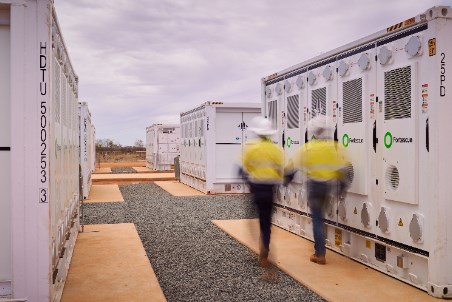United States Hybrid Power Solution Market Surges Ahead: – openPR.com

Report on the Hybrid Power Solution Market and its Contribution to Sustainable Development Goals
Market Overview and Projections
The Hybrid Power Solution Market is projected to experience a significant Compound Annual Growth Rate (CAGR) during the 2024-2031 forecast period. This market encompasses systems that integrate two or more energy sources—such as solar, wind, diesel, and battery storage—to deliver reliable, efficient, and sustainable power. The primary objectives of these solutions are to optimize energy consumption, decrease dependency on fossil fuels, reduce carbon emissions, and guarantee an uninterrupted electricity supply. These systems are critical for a wide range of applications, including remote, off-grid, and urban environments, directly supporting global sustainability efforts.
Alignment with Sustainable Development Goals (SDGs)
The expansion of the hybrid power solution market is intrinsically linked to the achievement of several United Nations Sustainable Development Goals (SDGs). The technology’s capacity to provide clean, reliable, and resilient energy infrastructure positions it as a key enabler for a sustainable future.
-
SDG 7: Affordable and Clean Energy
Hybrid power solutions are fundamental to advancing SDG 7. By combining renewable sources like solar and wind with energy storage, they provide a consistent and clean power supply, reducing reliance on standalone diesel generators. This is particularly vital for electrifying remote and off-grid communities, ensuring access to affordable and modern energy for all.
-
SDG 9: Industry, Innovation, and Infrastructure
The development and deployment of hybrid power systems represent significant innovation in the energy sector. These solutions contribute to building resilient, sustainable, and reliable infrastructure. The increasing adoption of utility-scale hybrid projects modernizes national grids and supports industrial growth with a stable and cleaner energy backbone.
-
SDG 11: Sustainable Cities and Communities
By ensuring a stable power supply and reducing the carbon footprint of energy generation, hybrid solutions help make cities and human settlements more inclusive, safe, resilient, and sustainable. They enhance energy security and can mitigate the impact of grid failures, which is crucial for critical urban infrastructure.
-
SDG 13: Climate Action
Hybrid systems directly contribute to climate action by significantly lowering greenhouse gas emissions. The integration of renewable energy sources minimizes the combustion of fossil fuels. As demonstrated by recent pilot programs, these systems can achieve substantial reductions in fuel consumption and generator operating times, directly combating climate change.
Recent Key Developments in the United States (U.S.)
Several recent developments in the U.S. underscore the market’s growth and its alignment with sustainability objectives:
- Industry Innovation Showcase (August 2025): Hybrid Power Solutions Inc. was selected for an exclusive Nevada Energy Storage Roadshow, highlighting its role in connecting innovative energy storage solutions with key U.S. energy sector stakeholders, fostering progress toward SDG 9.
- Utility-Scale Project Commissioning (July 2025): Enel North America operationalized a new hybrid plant in Texas, combining a 202 MW solar facility with a 104 MW battery energy storage system (BESS). This project is a direct contribution to SDG 7 and SDG 13 by adding significant renewable capacity to the grid.
- Industrial Adoption and Efficiency Gains (May 2025): A major U.S. construction company placed a significant order with Hybrid Power Solutions Inc. following a pilot program that demonstrated a 64% reduction in fuel consumption and a 76% reduction in generator runtime, showcasing a practical application of SDG 13 principles.
- Grid Resilience and Modernization (August 2025): A report indicating a potential 30% gap in power transformer supply for 2025 highlights the growing importance of distributed hybrid systems and off-grid solutions to ensure grid stability and support the connection of new renewable projects, aligning with SDG 9 and SDG 11.
- Growth in Hybrid Project Capacity (Q2 2025): Data from the U.S. Department of Energy confirmed a continuing trend where hybrid PV/battery projects constituted 45% of new battery capacity and 26% of new utility-scale PV capacity, indicating a systemic shift towards integrated renewable energy systems.
Market Segmentation
By Type
- Hydro and solar
- Solar and wind
- Hydro and wind
- Wind-hydrogen system
- Wind and diesel
- Solar and diesel
- More than 2 sources
By Power Rating
- Up to 10 kW
- 11 kW – 100 kW
- Above 100 kW
By Application
- Commercial & Industrial
- Residential
- Utility
Regional Analysis
The market analysis covers the following key regions:
- North America (U.S., Canada, Mexico)
- Europe (U.K., Italy, Germany, Russia, France, Spain, The Netherlands, Rest of Europe)
- Asia-Pacific (India, Japan, China, South Korea, Australia, Indonesia, Rest of Asia Pacific)
- South America (Colombia, Brazil, Argentina, Rest of South America)
- Middle East & Africa (Saudi Arabia, U.A.E., South Africa, Rest of Middle East & Africa)
Key Industry Players
The market features several major players driving innovation and deployment:
- General Electric Company
- Siemens Gamesa Renewable Energy SA
- Huawei Investment & Holding Co., Ltd
- Eltek Ltd
- Danvest BV
- PowerOasis Limited
- Electro Power Systems SA
- SMA Solar Technology AG
- Heliocentris Energy Solutions AG
- Vergnet SA
Analysis of Sustainable Development Goals in the Article
1. Which SDGs are addressed or connected to the issues highlighted in the article?
The article on the Hybrid Power Solution Market connects to several Sustainable Development Goals (SDGs) by focusing on the development and deployment of sustainable, reliable, and efficient energy systems. The primary SDGs addressed are:
- SDG 7: Affordable and Clean Energy: This is the most central SDG, as the article is entirely focused on hybrid power solutions that integrate renewable energy sources like solar and wind to provide clean and reliable electricity.
- SDG 9: Industry, Innovation, and Infrastructure: The article discusses innovative energy systems, the modernization of the electricity grid, and the development of resilient infrastructure to support new energy projects.
- SDG 13: Climate Action: By promoting solutions that reduce dependency on fossil fuels (like diesel) and lower emissions, the article directly addresses measures to combat climate change.
- SDG 11: Sustainable Cities and Communities: The text mentions providing continuous power for urban, remote, and off-grid applications, which is essential for creating sustainable and resilient communities.
2. What specific targets under those SDGs can be identified based on the article’s content?
Based on the information provided, several specific SDG targets can be identified:
- Under SDG 7 (Affordable and Clean Energy):
- Target 7.1: By 2030, ensure universal access to affordable, reliable and modern energy services. The article supports this by describing solutions that ensure “continuous electricity supply across remote, off-grid, and urban applications.”
- Target 7.2: By 2030, increase substantially the share of renewable energy in the global energy mix. The article highlights this with examples like Enel’s new solar-plus-storage plant and the statistic that hybrid PV/battery projects accounted for 26% of new utility-scale PV capacity.
- Under SDG 9 (Industry, Innovation, and Infrastructure):
- Target 9.1: Develop quality, reliable, sustainable and resilient infrastructure. The article points to the need for this by mentioning the U.S. grid’s transformer shortage and how distributed hybrid systems can enhance grid resilience.
- Target 9.4: By 2030, upgrade infrastructure and retrofit industries to make them sustainable. The example of a hybrid system paired with a diesel generator in the construction industry, which reduced fuel consumption by 64%, is a direct instance of retrofitting for sustainability.
- Under SDG 13 (Climate Action):
- Target 13.2: Integrate climate change measures into national policies, strategies and planning. The reported increase in utility-scale hybrid projects suggests a market trend driven by policies and strategies aimed at decarbonizing the energy sector.
- Under SDG 11 (Sustainable Cities and Communities):
- Target 11.6: By 2030, reduce the adverse per capita environmental impact of cities. The article implies progress toward this target by describing hybrid solutions that “lower emissions,” which would reduce the environmental footprint of urban energy consumption.
3. Are there any indicators mentioned or implied in the article that can be used to measure progress towards the identified targets?
Yes, the article contains several quantitative and qualitative indicators that can be used to measure progress:
- For Target 7.2 (Increase renewable energy share):
- The article states that “hybrid PV/battery energy storage system projects accounted for approximately… 26% of utility-scale PV capacity in the first half of 2024.” This percentage serves as a direct indicator of the growing share of renewable energy infrastructure.
- The specific capacity of new projects, such as the “202 MW solar photovoltaic (PV) facility” in Texas, is a measurable indicator of added renewable energy capacity.
- For Target 9.4 (Upgrade infrastructure for sustainability):
- The “64% reduction in fuel consumption” and “76% reduction in generator operating time” achieved by a construction company using a hybrid system are specific, measurable indicators of increased energy efficiency and sustainability in an industrial application.
- For Target 9.1 (Develop resilient infrastructure):
- The “projected 30% gap between the demand and domestic supply of power transformers” is a negative indicator highlighting vulnerabilities in the energy infrastructure, thereby underscoring the need for resilient solutions like distributed hybrid systems.
- For Target 13.2 (Integrate climate measures):
- The report that hybrid projects accounted for “approximately 45% of new battery capacity” in early 2024 is an indicator of the large-scale integration of technologies that support renewable energy and climate goals.
4. Summary Table of SDGs, Targets, and Indicators
| SDGs | Targets | Indicators |
|---|---|---|
| SDG 7: Affordable and Clean Energy | 7.2 Increase substantially the share of renewable energy in the global energy mix. | Percentage of new utility-scale capacity from hybrid PV projects (26%); Total MW capacity of new solar facilities (e.g., 202 MW plant). |
| SDG 9: Industry, Innovation, and Infrastructure | 9.4 Upgrade infrastructure and retrofit industries to make them sustainable. | Percentage reduction in fuel consumption (64%) and generator operating time (76%) in industrial applications (construction). |
| SDG 13: Climate Action | 13.2 Integrate climate change measures into national policies, strategies and planning. | Share of new battery capacity attributed to hybrid projects (45%), indicating a systemic shift towards renewable-enabling technology. |
| SDG 11: Sustainable Cities and Communities | 11.6 Reduce the adverse per capita environmental impact of cities. | Deployment of hybrid solutions that “lower emissions” in urban applications. |
Source: openpr.com

What is Your Reaction?
 Like
0
Like
0
 Dislike
0
Dislike
0
 Love
0
Love
0
 Funny
0
Funny
0
 Angry
0
Angry
0
 Sad
0
Sad
0
 Wow
0
Wow
0



















































.jpg.webp?itok=0ZsAnae9#)

























